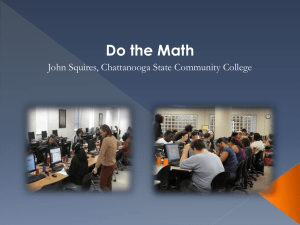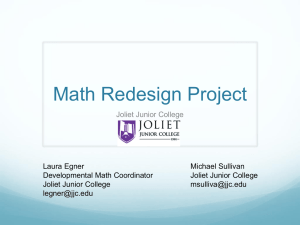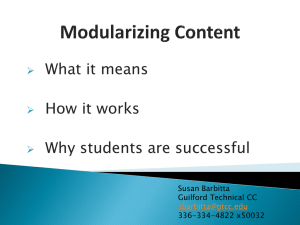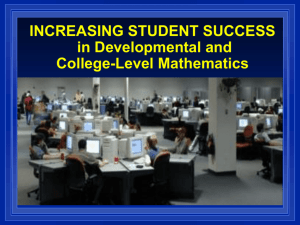Karen Wyrick
advertisement
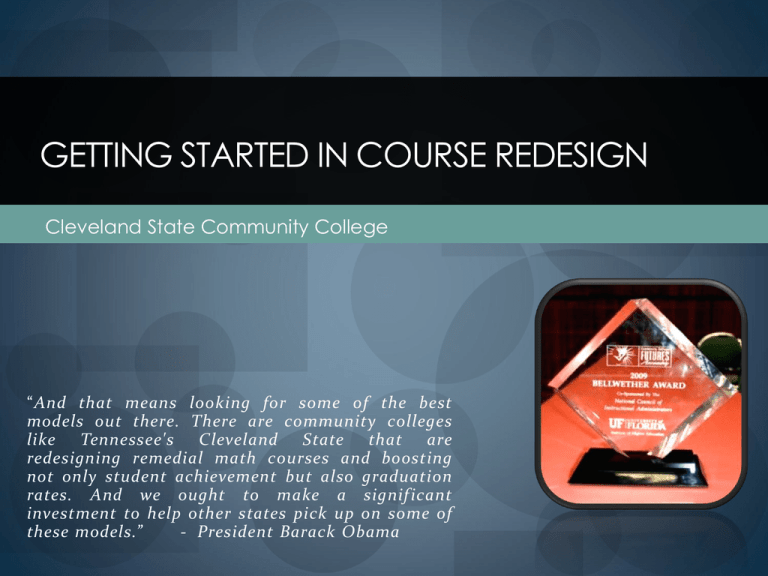
GETTING STARTED IN COURSE REDESIGN Cleveland State Community College “And that means looking for some of the best models out there. There are community colleges like Tennessee's Cleveland State that are redesigning remedial math courses and boosting not only student achievement but also graduation rates. And we ought to make a signif icant investment to help other states pick up on some of these models.” - President Barack Obama Houston, We Have A Problem The Problem – Developmental Math High failure rates Low attendance Good students stuck for 1 – 2 semesters Roadblock to student success The Solution – Course Redesign Try something new Completely different approach Utilize online learning systems Remove roadblock to success TBR Involved In System-Wide Redesign How long did it take? Semester 1 - Worry Yes, we are going to do this Oh no, we are going to do this What exactly are we supposed to do? Read and research Semester 2 - Plan What is everyone else doing? What works? What does not? Take a field trip Talk about specifics Semester 3 - Implement Spring 2008, Elementary Algebra and Intermediate Algebra Semester 4 – Tweak and Move On Fall 2008: Basic Math, College Algebra, Statistics, Finite Math Fall 2009: Precalculus I, Precalculus II, and Applied Calculus Hit the Highlights 3 Developmental Math Classes Basic Math, Elementary Algebra, Intermediate Algebra Emporium Model Mastery Learning 7 College Math Classes College Algebra, Finite Math, Statistics (1 + 2) Precalculus I & II, Applied Trig, Business Calculus (2 + 1) Emporium Model Mastery Learning Our Little Twists* Course Layout Each course consists of 10 – 12 mini-modules* 1 hour class meeting each week – students work in class* 2 hours work outside class each week – at least 1 hour in lab Students expected to complete one module each week* Course Grade 10% Attendance Grade - class & lab attendance, module finished 30% Homework Sets – 2 to 5 sections per module 60% Quiz and Exam Grades – 1 quiz each module, 2 exams Course Standards Students must complete every homework set (70 or better) Students must pass every module quiz and exam (70 or better) Students must pass attendance grade (70 or better) Students may take each quiz and exam multiple times *Our Little Twists On NCAT Recommendations Our Non-Negotiables Emporium Mastery Learning Bite–sized approach Points for everything Nothing is optional Technology based Attitude Adjustments Before Redesign After Redesign Students Students I want my lecture! I like this! Study night before exam Weekly homework, quiz What do I need to pass? I want an A. Teachers Teachers I want my lecture! This works! Class Class Low attendance Median attendance grade 88 Don’t do homework Average homework grade 97 Not engaged in class Come to class early, stay late Results Update Developmental Math Basic Math increased from 48% before to 53% after (still needs work) Elementary Algebra increased from 52% before to 67% after Intermediate Algebra increased from 55% before to 71% after College Level Math College Algebra increased from 65% before to 77% after Introductory Statistics decreased slightly from 79% before to 73% after Finite Math increased from 75% before to 89% after Precalculus I increased from 55% before to 75% after Precalculus II increased from 75% before to 81% after Doing More with Less Math department has grown 40% since redesign (from 1100- to 1600+) College Math enrollment is 800+ S2011 – more than Dev Math Cost/FTE has been reduced by over 40% College retention increased by 7% in Spring 2009 ($400K revenue) Number of students passing a math course increased by 50+%!!! Much Ado About Something TBR Study (Schutz & Tingle) - Cleveland State Redesign ◦ Students tracked 3 semesters before and after redesign ◦ Students tracked from dev math into college math ◦ Examined impact on course success & next course success ◦ Logistical regression, significance level 95% The Results ◦ Redesign had a strong positive impact on course success ◦ Redesign had a strong positive impact on next course success, including both dev math and college math ◦ Gender and race were not factors in predicting course success - achievement gaps were closed Reap the Benefits Scheduling Benefits Continuous Enrollment Plan One Room Schoolhouse Math on Demand Quality Matters Consistency is improved through online instruction Student success increases through a redesign approach Dual Enrollment Passing rates often 100% in these courses Our campus or yours; our instructor or yours MML Features Batch enrollment – students work on day one Personalized homework after first quiz attempt Leadership and Teamwork Leadership is essential to a successful redesign project Someone has to say “We are going to do this” Putting the right person in charge is essential Teamwork is an important part of course redesign Getting faculty involved helps get buy-in Administration and faculty must work together The Turning Point Focus at beginning is on resistance to change Once everyone focuses on “How do we make this work?” success will follow – it is only a matter of time Final Thoughts Redesign (not redesign) Don’t be afraid to try something new. It might work! Goal: Transformation Lawrence - “I’ve decided that I like math.” Jacqueline – “My confidence is so much better. If I can do this, I can do anything.” Lakeisha – “Let me show you how I learned this.” Questions? Karen Wyrick kwyrick@clevelandstatecc.edu


